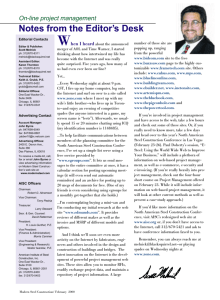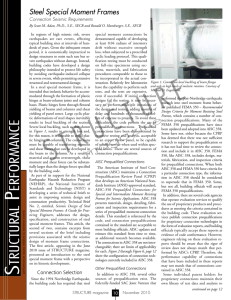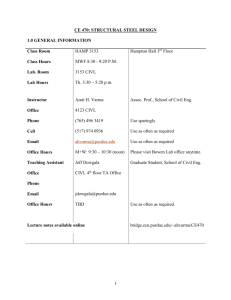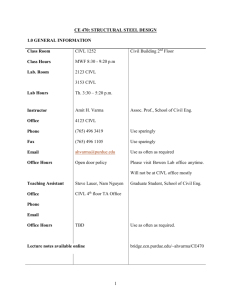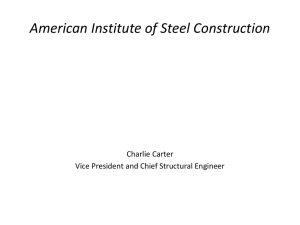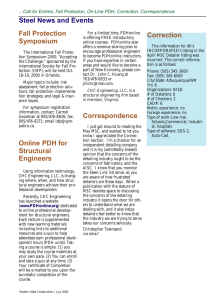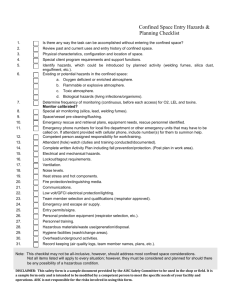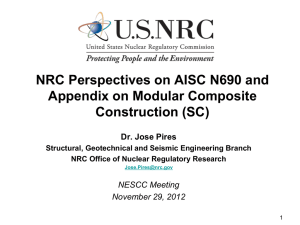Prequalified Moment Connections - Modern Steel Construction
advertisement
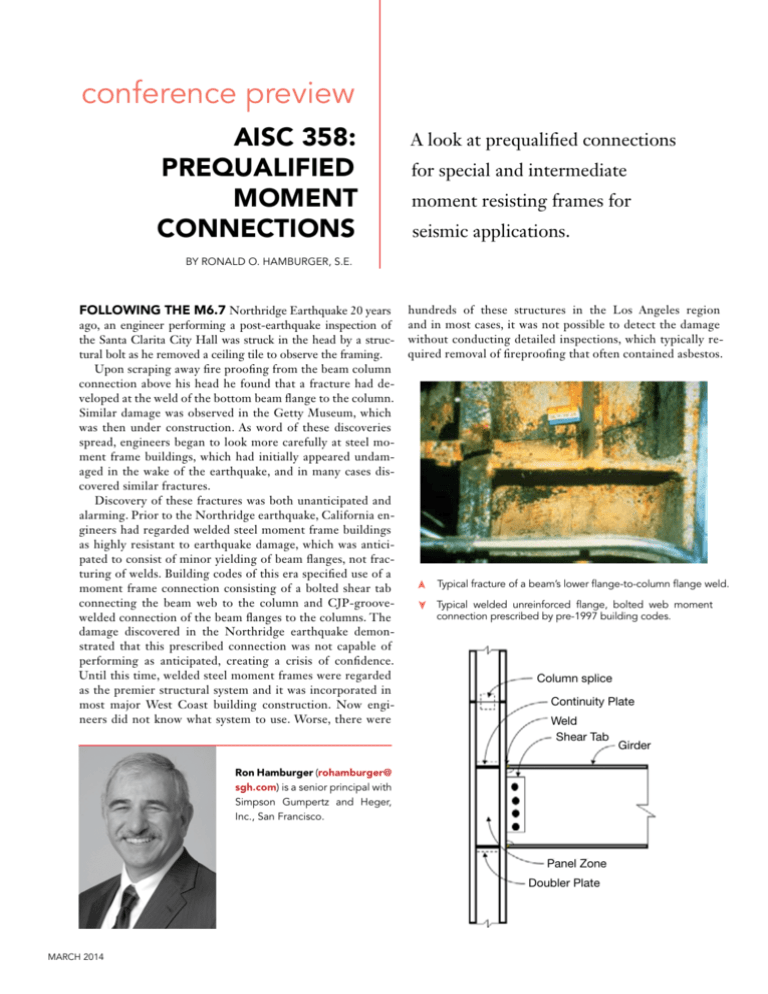
conference preview AISC 358: Prequalified moment connections A look at prequalified connections for special and intermediate moment resisting frames for seismic applications. by ronald o. hamburger, s.e. hundreds of these structures in the Los Angeles region and in most cases, it was not possible to detect the damage without conducting detailed inspections, which typically required removal of fireproofing that often contained asbestos. ➤ ago, an engineer performing a post-earthquake inspection of the Santa Clarita City Hall was struck in the head by a structural bolt as he removed a ceiling tile to observe the framing. Upon scraping away fire proofing from the beam column connection above his head he found that a fracture had developed at the weld of the bottom beam flange to the column. Similar damage was observed in the Getty Museum, which was then under construction. As word of these discoveries spread, engineers began to look more carefully at steel moment frame buildings, which had initially appeared undamaged in the wake of the earthquake, and in many cases discovered similar fractures. Discovery of these fractures was both unanticipated and alarming. Prior to the Northridge earthquake, California engineers had regarded welded steel moment frame buildings as highly resistant to earthquake damage, which was anticipated to consist of minor yielding of beam flanges, not fracturing of welds. Building codes of this era specified use of a moment frame connection consisting of a bolted shear tab connecting the beam web to the column and CJP-groovewelded connection of the beam flanges to the columns. The damage discovered in the Northridge earthquake demonstrated that this prescribed connection was not capable of performing as anticipated, creating a crisis of confidence. Until this time, welded steel moment frames were regarded as the premier structural system and it was incorporated in most major West Coast building construction. Now engineers did not know what system to use. Worse, there were Typical fracture of a beam’s lower flange-to-column flange weld. ➤ Following the M6.7 Northridge Earthquake 20 years Typical welded unreinforced flange, bolted web moment connection prescribed by pre-1997 building codes. Column splice Continuity Plate Weld Shear Tab Ron Hamburger (rohamburger@ sgh.com) is a senior principal with Simpson Gumpertz and Heger, Inc., San Francisco. Panel Zone Doubler Plate march 2014 Girder ➤ Column profiles permitted under AISC 358. The International Conference of Building Officials, predecessor to the International Code Council, issued an emergency code change, removing the prescribed connection from the code and requiring that engineers demonstrate, by cyclic testing, that connection designs would be capable of providing adequate ductility. The SAC Joint Venture Shortly after the earthquake, the Federal Emergency Management Agency funded a joint venture of the Structural Engineers Association of California, the Applied Technology Council and the Consortium of Universities for Earthquake Engineering. Known as SAC, the group’s goals were to study the cause of this damage and develop recommendations for inspecting buildings for damage, repairing damage, evaluating the probable performance of undamaged buildings in future earthquakes and designing new, more earthquakeresistant construction. Over a five-year period, the SAC Joint Venture performed extensive research including hundreds of laboratory tests and thousands of frame analyses. This work culminated in the FEMA 350-355 series of publications that included extensive engineering and design guidelines. The FEMA publications identified several causes for the damage. The pre-Northridge connection geometry resulted RBS BUEEP (a) (b) in stress and strain concentrations under conditions of high restraint, precluding the possibility of yielding in areas of highest stress. High variability in steel yield strength made it difficult to determine where in a beam-to-column joint yielding would occur. The presence of backing bars and weld runoff tabs, common accessories in beam-flange-tocolumn-flange CJP groove welds, resulted in stress risers and notch effects. Finally, welds were commonly made with low-toughness filler metals and without conforming to appropriate welding procedure specifications. AISC 358 FEMA-350, one of several publications produced by SAC, provided design criteria for a series of eight tested connections recommended for use in special and intermediate moment frames. However, FEMA350 was not an ANSI standard and could not be adopted by the building codes. Therefore, in 2001, AISC established the Connection Prequalification Review Panel (CPRP) as a standards committee to develop a connection prequalification standard. The CPRP is composed of engineers, researchers, fabricators and building officials. The panel reviewed testing and other research data performed by SAC and others, and in 2005 published the first BSEEP Collar flange assembly (c) BFP Concrete fill Cover plate Horizontal shear plate Vertical shear unstiffened,element Fig. 6.1. Extended end-plate configurations: (a) four-bolt 4E; (b) four-bolt stiffened, 4ES; (c) eight-bolt stiffened, 8ES. Collar corner assembly Moment beams on any or all faces Side plate (a) ➤ WUF-W (b) KBB Figure 9.1. Kaiser bolted bracket connection. (a) W-series connection; (b) B-series connection. a b Square steel HSS or built-up column ConXL SidePlate Prequalified moment connections. Modern STEEL CONSTRUCTION conference preview edition of AISC 358. This first edition included prequalifications data and design procedures for three connection types: reduced beam section (RBS), bolted unstiffened extended end plate (BUEEP) and bolted stiffened extended end plate (BSEEP). These connections could be used to connect beams to the major axis of wide-flange columns but also permitted connection to built-up box columns, boxed wide-flange columns and cruciform wide-flange columns. The publication of AISC 358-05 made it practical, once again, for engineers to design code-conforming steel moment frame structures in regions of high earthquake risk. Following publication of AISC 358-05, the CPRP continued to review data for additional connection technologies. This data was available in the public domain, but was also provided by developers of proprietary connections. Over the years, the CPRP issued Supplements to AISC 358 with additional prequalified connections and in 2010, an updated standard. Supplement No. 2 to AISC 358-10 has just been completed and the committee is continuing to work on the 2016 edition of the standard. Supplement No. 2 to AISC 358-10 includes a total of eight connections. In addition to RBS, BUEEP and BSEEP, these include: bolted flange plate (BFP); welded unreinforced flange, welded-web (WUF-W); Kaiser Bolted Bracket march 2014 (KBB); CoXtech (ConXL); and SidePlate connections. (The KBB, ConXL and SidePlate connections are proprietary, while the other connections are public domain; proprietary connections can be used only with proper licensing from the patent holder.) In addition to these connections, approval is nearly ready for a bolted double-tee connection and the proprietary Simpson StrongFrame connections. Several additional proprietary connections are also being considered. Superior Performance The last twenty years have seen tremendous development in the connection technologies available for steel moment frame connections. Prior to the Northridge earthquake, only one connection type was available. Then, after the earthquake there were none. Soon engineers will have 10 connection technologies to choose from, each of which has undergone extensive testing and review. Following future earthquakes, engineers may again expect to see superior per■ formance of steel moment frame buildings. This article serves as a preview of Session C6, “AISC 358: Prequalified Moment Connections” at NASCC: The Steel Conference, taking place March 26-28 in Toronto. Learn more about the conference at www. aisc.org/nascc.
